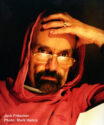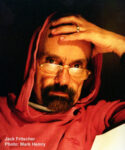Chapter also available in PDF
TV’S QUEASY KID STUF
SESAME STREET
Try on a parent’s point of view
and see if you can make it through
the Saturday AM teleworld.
By the time today’s child hits kindergarten, he’s logged 3,000 hours of TV. He’ll watch 12,000 more hours before he graduates from high school. So how can a parent be surprised when his three-year-old toddles in reciting the “Pledge of Allegiance”? Who taught him that? TV taught him that. And plenty more.
BANG! You’re dead!
TV creates the American child’s world.
Preschoolers watch weekday cartoons from nine to ten a.m. and grade-schoolers are programmed from 3:30 to six p.m. Besides the daily programming of the local Romper Room aired daily with Miss Nancy by local stations, the network series, Captain Kangaroo, and the independent series, Sesame Street, kids get it socked to them the hardest on Saturday mornings. And some of the socking could be hazardous to their health.
The Monkees rock ‘n’ roll series reruns daytimes to great applause. Their style, patterned after the early Beatles films, has filtered down the last few seasons from the teenybopper to the bubblegummer. (Bubblegummer is the name business has for the preschoolers who not only have their own money, but also influence what their parents buy.)
When The Monkees fast-pace crosses with Laugh-ln’s quick episodes, the kids get something excellent: Sesame Street.
If today’s preschooler isn’t watching Sesame, he’ll be behind his kindergarten competition. To augment Project Headstart, two National Councils, of Negro and of Jewish Women, have promoted the Sesame series in the ghettoes. VISTA workers have organized viewing groups. RCA and other corporations have donated over two hundred Television-Sets-for-Sesame. Sesame opens the child.
Sesame Street is ultimate TV. It uses image and sound. Turn off the picture and the child can’t follow the show any more than you can follow the action of a pictureless Mission: Impossible that never has much dialogue. For contrast, turn off Bonanza’s or Disney’s picture; the ear still follows the plot. Until recently most TV shows have been no more than old radio shows glorified with electronic images.
Sesame Street has caught the commercial network executives up short. The network moguls have most often limited children’s programs to old cartoons, an occasional Heidi, and a 2.5 million dollar budget for Captain Kangaroo. Little did they care about program quality as long as the commercials tricked the kids into nagging their parents to buy certain cereals, certain soaps, and certain toys.
Suddenly, Sesame Street with eight million dollars (half from private foundations and half from Federal funds) re-imagined TV’s successfully slick commercial sell. Sesame creator Joan Cooney now “sells” the alphabet, and counting, and the differences between squares, triangles, and rectangles to two through five-year-olds on three hundred stations. Sesame thus sets the record for the largest exposure ever of any regular series. That makes those TV moneymen blanch a bit. Coming soon? A second Sesame series for seven to ten-year-olds with emphasis on reading skills.
Repetition is the key to education. Sesame’s repetition of image and sound is its essence. Adults may find repetition a bore, but kids (in the age group who like to have the same bedtime story repeated nightly) don’t. They groove and improve on it. They like the familiar mixture of puppets, drawings, films, games, animals, and especially conversations.
Sesame is one program that knows kids. And respects them. It doesn’t condescend. Its psyching is right on the beam. This year’s first-grade teachers had to adjust their attitudes, curriculum, and methods to the Sesame Generation.
The best art supposedly conceals its art. Sesame Street has far more form than is apparent. Each program is carefully divided into five segments, with each segment repeated in various forms throughout the sixty-minute barrage.
Sesame Street, Episode 119 was structured as follows:
LETTERS: I, P, U. Jackie Robinson recites the alphabet. The hidden attitude is that black men can be intellectual leaders and lose none of their cool masculinity.
NUMBERS: 8, 9. The concept of quantity.
EMOTIONS: The child learns how to act out and understand his inner feelings and tensions.
CONCEPTS: The idea of more in comparison to the idea of less; points of view (teaches development of the critical ability to reason and distinguish).
SONG: “Counting.” (Often stories or films are substituted.)
If ever TV had one, Sesame Street is a real variety show.
* * * *
The best of Saturday programs is The Banana Splits and H. R. Pufnstuf. Pufnstuf stars fifteen-year-old British actor, Jack Wild, an Oscar-nominee for Oliver. From an adult point of view, Pufnstuf is easier to take. It’s a kind of a mod Wizard of Oz which mixes musical numbers with bell-bottoms, and amusing humans with friendly gremlins.
The Banana Splits is part of the Hanna-Barbera Animation Empire. If Disney dominates theatre films, HB rules the telescreens. Hanna-Barbera left the Hollywood studios in the early sixties to launch their own Huckleberry Hound. Huck and his friends now run the world of Bubblegum. Their mixture of cartoons like Hillbilly Bears and live-action series like Danger Island is a notch or two above some other cartoons like Heckle and Jeckle, Tom Slick, and George of the Jungle. In these shows some very strange attitudes affect the child.
Much TV has a sad morality.
Where Sesame Street emphasizes songs about “What Fathers Do,” many kid-shows portray “Daddy as a Dummy.” Hardly better than Jackie Gleason’s The Honeymooners (which provides the plots for The Flintstones) many children’s shows use the same “Dagwood Syndrome” that has marred adult sitcoms for years. Does exposing children to stupid TV males and spineless fathers alter their respect for paternal intellect and authority? Can they admire only the violently strong super-heroes like Spider Man or The Super 6?
A second sad thing to catch Saturday mornings—besides the violence—is the absence of women. Clutch Cargo wouldn’t know what to do with a lady. When, however, a woman is present, she is either dizzy and helpless, like Penelope Pittstop, or comically evil like Witchy-Poo on Pufnstuf or Sabrina’s aunt on The Archie Show. It’s very difficult for a little girl to learn from TV what her role as a woman will one day be.
Don’t make a judgment, however, until you sit down two or three Saturdays and catch the Bubblegum teleworld. Like it or not, this is what the kids see. We can’t deny them the TV; there’s too much good to be learned from it. We can BIFF BAM POW watch their programs and try to straighten out in conversation what we find faulty or plain wrong. We can creatively take the occasion to hone the beginning of the critical thinking faculties they’ll need to make it through the media-crush of contemporary electronic life.
Censorship, it bears repeating, is a delicate thing.
Turning off the set makes it attractive forbidden fruit. Turning off won’t do. The creative and open-minded parent (or older brother and sister) knows what the children are seeing and uses that exposure as a stepping stone to reinforce the good and explain the dubious.
The creative parent uses the controversial program to start a conversation with his child. Through communication comes mutual understanding. Watch the kids’ shows and learn about the kids’ world. They have no choice but to live in it. They need non-uptight adults to show them how to cope with divergent concepts.
Adults have the choice of understanding this new “Imageneration”—or not.
Wise are the parents these days who have discussions with their kids from infancy on up.
Conversation is what friends have, right?


